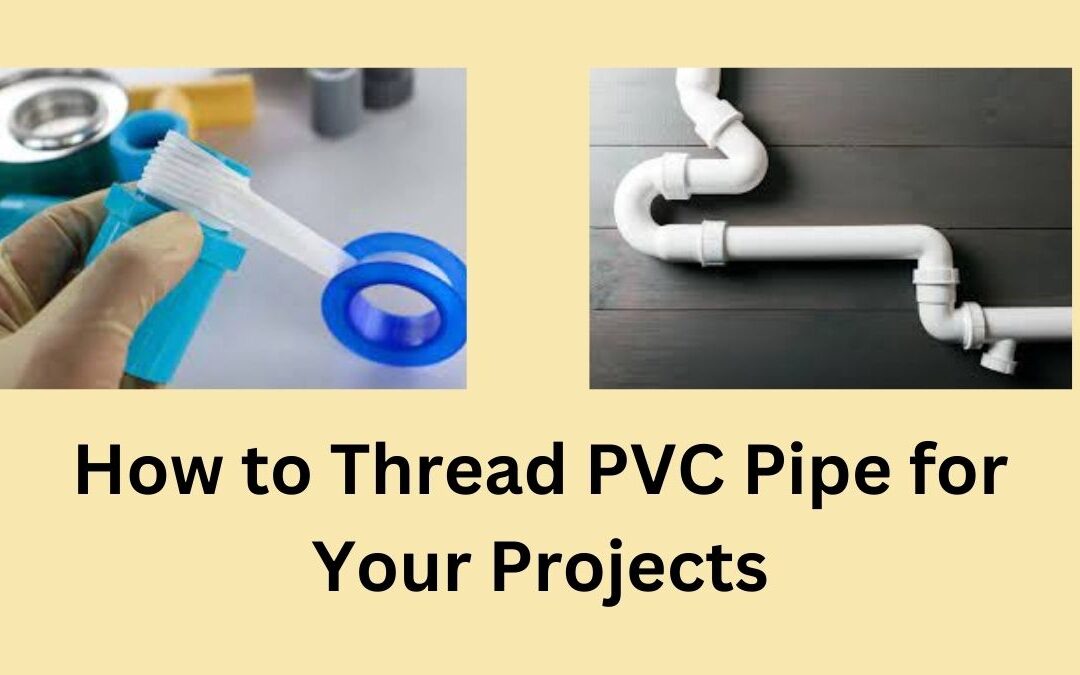If you’re undertaking a DIY project or working on plumbing installations, knowing how to thread PVC pipe is a valuable skill. Threading PVC pipe allows you to create secure and leak-free connections for your projects. Whether you’re joining pipes for irrigation systems, plumbing applications, or other projects, understanding the threading process is essential.
Threading PVC pipe involves creating threads on the pipe ends that interlock with fittings, providing a tight and reliable connection. This technique allows for easy assembly and disassembly, making repairs or modifications more manageable.
In this guide, we will walk you through the step-by-step process of threading PVC pipe, covering the tools you’ll need, safety considerations, and the threading techniques. Whether you’re a beginner or have some experience with PVC pipe projects, this guide will provide you with the knowledge and confidence to thread PVC pipe effectively.
So, let’s dive in and discover the essential steps to thread PVC pipe for your upcoming projects.
How to Thread PVC Pipe for Seamless Connections?
Achieving seamless connections when working with PVC (polyvinyl chloride) pipe is crucial for ensuring leak-free and reliable installations. Threading PVC pipe is a skill that allows you to create such connections easily. In this step-by-step guide, we will walk you through the process of threading PVC pipe, ensuring that you achieve seamless results.
- Prepare the necessary tools: Gather a pipe threader, lubricant, and a vice to secure the pipe during threading.
- Measure and mark the pipe: Use a measuring tape to determine the length of the threaded section and mark it with a pencil or marker.
- Secure the pipe: Place the pipe securely in the vice to prevent movement during threading.
- Apply lubricant: Coat the pipe end and the threader with lubricant to reduce friction and ensure smooth threading.
- Begin threading: Position the threader at the marked section and rotate it clockwise to cut the threads into the pipe.
- Remove debris: After completing the threading, use a brush or cloth to remove any debris or excess lubricant from the threaded section.
By following these steps, you can effectively thread PVC pipe and achieve seamless connections for your projects. Remember to practise proper safety measures and take your time to ensure accurate threading.
Essential Tips for Threading PVC Pipe
When it comes to threading PVC (polyvinyl chloride) pipe, following essential tips can help you achieve successful and reliable results. Threading PVC pipe allows for secure connections and is commonly used in plumbing and DIY projects. To ensure smooth and effective threading, consider the following tips:
Choose the right pipe threader: Select a threader that matches the pipe size you’re working with to ensure accurate threading.
Use lubrication: Apply a suitable lubricant to the pipe and the threader to reduce friction and facilitate smooth threading.
Secure the pipe: Use a vice or clamp to hold the pipe firmly in place, preventing movement during threading.
Maintain steady pressure: Apply consistent pressure while turning the threader to cut the threads gradually and evenly.
Avoid over-threading: Be cautious not to over-thread the pipe, as this can weaken the connection or lead to leaks.
Clean and inspect the threads: After threading, remove any debris or excess lubricant and inspect the threads for any imperfections.

Learn How to Thread PVC Pipe with Confidence
Threading PVC (polyvinyl chloride) pipe may seem daunting at first, but with the right knowledge and approach, you can master this skill and thread PVC pipe with confidence. Whether you’re a beginner or have some experience with DIY projects, learning how to thread PVC pipe opens up a world of possibilities for plumbing and construction applications. Here are some key steps to help you get started:
- Gather the necessary tools: You’ll need a pipe threader, pipe cutter, and pipe vise to facilitate the threading process.
- Measure and mark: Use a measuring tape to determine the desired length for the threaded section and mark it on the pipe.
- Secure the pipe: Place the pipe securely in the vise to prevent movement during threading.
- Begin threading: Position the threader on the marked section of the pipe and rotate it clockwise to cut the threads.
- Inspect and clean: After threading, carefully inspect the threads for any imperfections and remove any debris.
With practice, patience, and attention to detail, you can learn how to thread PVC pipe confidently. Remember to follow safety guidelines and consult resources for additional guidance. Soon, you’ll be able to tackle various projects with ease, knowing that you can thread PVC pipe like a pro.
Mastering the Art of Threading PVC Pipe
Threading PVC (polyvinyl chloride) pipe is a valuable skill that allows you to create secure and reliable connections for your plumbing and construction projects. Mastering the art of threading PVC pipe takes practice, precision, and attention to detail. By following the steps below, you can enhance your threading skills and achieve professional results:
Select the right tools: Ensure you have a pipe threader, lubricant, and a pipe vise to facilitate the threading process.
Measure and mark: Use a measuring tape to determine the desired length for the threaded section and mark it on the pipe.
Secure the pipe: Place the pipe securely in the vise to prevent movement during threading.
Apply lubricant: Apply a suitable lubricant to the pipe and the threader to reduce friction and ensure smooth threading.
Thread the pipe: Position the threader on the marked section and rotate it clockwise, applying steady pressure to cut the threads into the pipe.
Inspect and clean: After threading, inspect the threads for any imperfections and remove any debris or excess lubricant.
Step-by-Step Tutorial: Threading PVC Pipe Like a Pro
Threading PVC (polyvinyl chloride) pipe is a fundamental skill that allows you to create secure and reliable connections for your plumbing and construction projects. By following this step-by-step tutorial, you can learn how to thread PVC pipe like a pro:
Gather the necessary tools: Ensure you have a pipe threader, lubricant, pipe cutter, and pipe vise.
Measure and mark: Use a measuring tape to determine the desired length for the threaded section and mark it on the pipe.
Secure the pipe: Place the pipe firmly in the vise to prevent movement during threading.
Apply lubricant: Coat the pipe end and the threader with lubricant to reduce friction and ensure smooth threading.
Begin threading: Position the threader at the marked section and rotate it clockwise, gradually cutting the threads into the pipe.
Clean and inspect: After threading, remove any debris, excess lubricant, and inspect the threads for any imperfections.
Releted Post :Can you use Plumbing PVC for Electrical Conduit? |Can you run Romex in PVC Conduit? |Can I use White PVC for Electrical Conduit?|Will salt damage PVC pipe? |How to Remove Dried PVC Glue from Pipes?|How to Connect Copper Pipe to PVC?|How Long Does PVC Pipe Last? | Innovative PVC Pipe Dishwasher Designs for Modern Kitchens
Conclusion
In conclusion, mastering the technique of threading PVC (polyvinyl chloride) pipe is an invaluable skill for various plumbing and construction projects. By following the step-by-step instructions and incorporating the right tools and techniques, you can thread PVC pipe with confidence and precision.
Threading PVC pipe allows you to create secure and reliable connections, ensuring the integrity and longevity of your installations. Remember to measure and mark the pipe accurately, secure it firmly in a vise, and apply lubricant to reduce friction during the threading process.
With patience and practice, you can become proficient in threading PVC pipe like a professional. Whether you’re a DIY enthusiast or a seasoned contractor, the ability to thread PVC pipe opens up a world of possibilities for your projects.
So, equip yourself with the necessary tools, familiarise yourself with the process, and dive into your next project with the confidence to thread PVC pipe effectively. With the knowledge and skills acquired, you’ll be able to tackle plumbing and construction tasks with ease and achieve professional-grade results.

